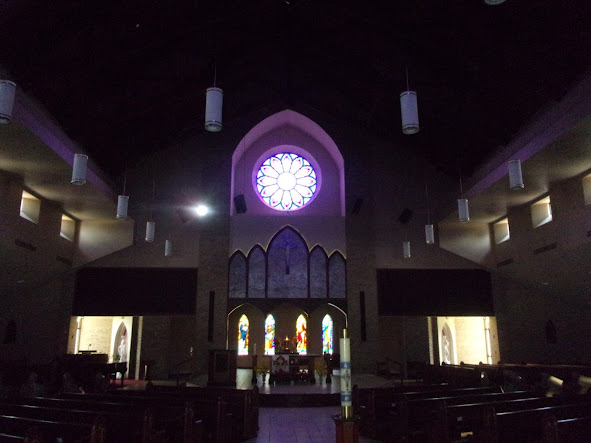Saint Anthony de Padua
Angola
One of the unusual quirks about the parish, is the fact that the part of the sanctuary that butts outs from the church sits underneath an overhang. Personally, I find it an odd choice, either have a flat wall with a large stained glass window, or have the traditional semicircle or quasi-octagonal room off the back wall. A case in point is Saint Paul's Lutheran church in Fort Wayne.
A closer photo of the entryway. As mentioned before this was from a pervious parish. Normally in Catholic architecture there is a small portal or gate that the person walks through to enter the church. in large churches there are three with the largest in the center. In this parish however, instead of the portal being a thick, stone, entryway, it is shrouded by stained glass. It's an interesting and unique choice for this parish
This space is also unique to churches built in the last 20 years; an abnormally large narthex, or gathering space. Whereas in centuries before Mass was predominantly for the worship of God, in 1950's American culture it developed into a dual facet of the worship of God and meet and greet with neighbor. This has become physically evident in some churches where the narthex rivals the size of the nave itself. (A full deep dive onto the last century of Catholicism in America is an entirely different blog)
Another modern facet is the heavy reliance on modern lighting. In some churches there is so little lighting that the abundance of lighting created the dull, persistent, florescent hum that slowly grates on anyone unfortunate to hear it. Thankfully, Saint Anthony was spared from this characteristic. The church does still have two rose windows that bathe the church in a purple color. Some observations can be made in the dim light. The piano in the sanctuary, the altar in the near center of the church, and the small table style altar are all hallmarks of modern Catholicism, even in older built churches.
Above and below are the two rose windows of the church. It is unusual to see such a heavy use of purple in stained glass. Usually the predominant color is blue, and sometimes yellow, orange, and/or red. The Lilly at the center of the above window is a classic symbol of purity and chastity, something that Saint Anthony would have taken a vow of purity for. The below window is markedly similar to the other rose window, give for the lack of symbol in the center. Perhaps a hammer as Saint Anthony was known as the 'hammer of heretics' or as bizarre as it sounds a tongue. Saint Anthony's tongue's is incorrupt as he was such an effective preacher, able to reach the learned and the simple minded. The tongue is able to be viewed at the Basilica of Saint Anthony in (you guessed it) Padua
***
One facet of modern churches that I find frustrating is the bringing out of the altar to the near center of church, while leaving the tabernacle behind, and a large awkward gap in the middle. The effects of this are visible: Having the pews surround the altar while Jesus truly present in the tabernacle, is shoved into some dimly lit room. Thankfully, at Saint Anthony's the Franciscans who staff the parish have kept the tabernacle in the center of the church.
A close up of the tabernacle. Behind Jesus are the four evangelists in stained glass. The pedestal on which the tabernacle resides is well decorated.
Aside from the two rose windows, these small widows were the only natural light occurring within the church.
The stations were very small and simple for the scale of the church. If had to wager, I'd bet they were from a previous parish. That being said, they do carry a certain charm that is lost in other, extravagant depictions of the stations. I'm a firm believer that beauty can be found in simplicity and these stations are a testimony to that fact.
















No comments:
Post a Comment